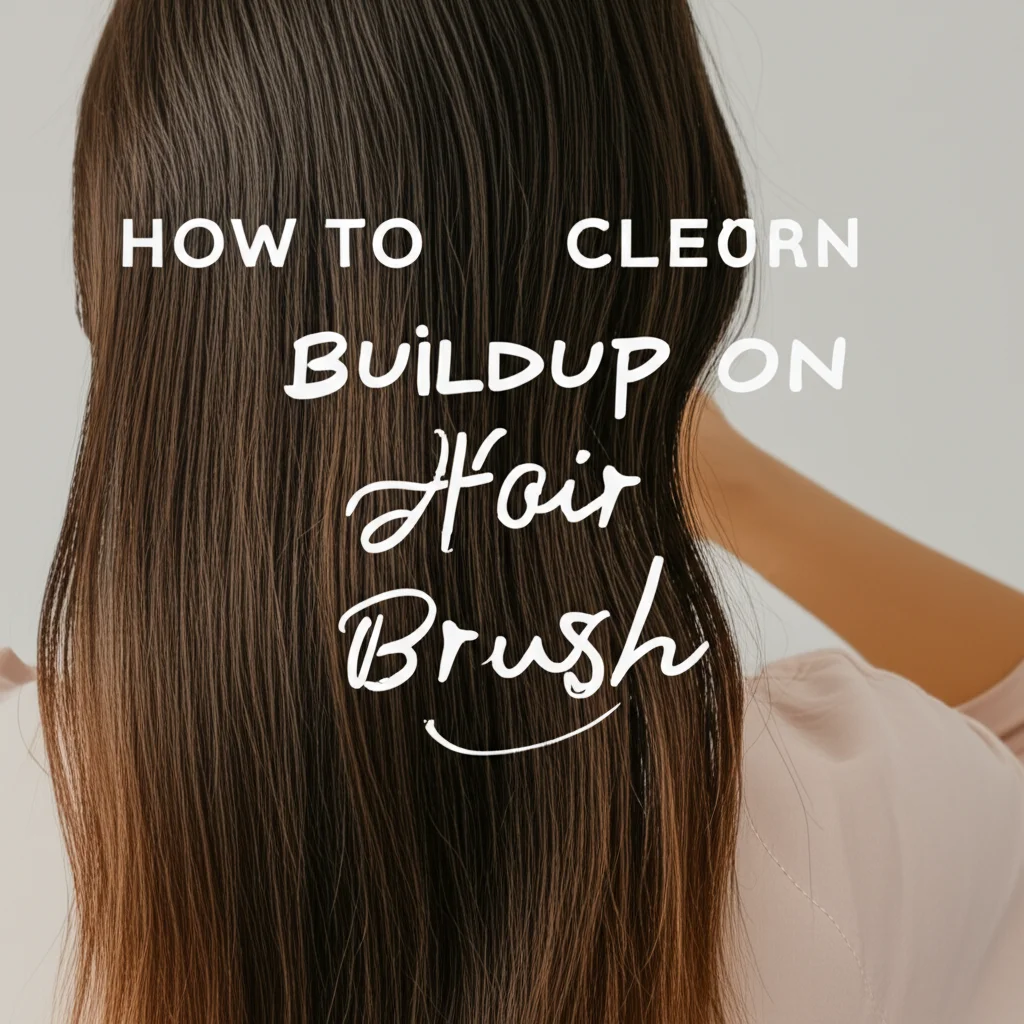· Todd Martin · Home & Living · 19 min read
How To Clean Buildup On Hair Brush

How To Clean Buildup On Hair Brush Effectively
Have you ever wondered why your freshly washed hair still feels a bit weighed down or lacks shine? The culprit might be your hair brush. Over time, hair brushes accumulate a surprising amount of buildup, including loose hair, dust, product residue, natural oils, and even dead skin cells. This grime transfers back to your clean hair, defeating the purpose of washing it. A dirty hair brush not only impacts your hair’s appearance but also its health and hygiene.
Cleaning the buildup on your hair brush is an essential, yet often overlooked, part of a healthy hair care routine. A clean brush performs better, distributes natural oils more evenly, and keeps your scalp healthy. In this comprehensive guide, I will show you how to effectively clean buildup on any hair brush type. You will learn about the tools you need, simple step-by-step methods for different brushes, how to tackle stubborn residue, and important tips for ongoing maintenance. Keeping your hair tools pristine is easier than you think, and the benefits for your hair are truly remarkable.
Takeaway:
- Regularly remove loose hair and visible debris from your brush after each use.
- Perform a weekly light clean with warm water and soap to remove oils and product buildup.
- Deep clean brushes monthly or bi-monthly, using methods tailored to the brush material, like baking soda or vinegar soaks.
- Sanitize brushes periodically to eliminate bacteria and fungi for optimal hygiene.
- Allow brushes to air dry completely, especially wooden ones, to prevent mold and damage.
Cleaning buildup on a hair brush involves first removing all loose hair with a comb or scissors. Then, depending on the brush type and material, you can soak it in a gentle solution of warm water and shampoo, or a mixture of baking soda and water, to dissolve product residue and oils. Finish by scrubbing gently with an old toothbrush and rinsing thoroughly.
Why Your Hair Brush Gets Dirty (And Why It Matters)
It is easy to assume your hair brush is just a tool for styling, but it acts like a magnet for various particles. Each time you run it through your hair, it collects more than just loose strands. Understanding what makes your hair brush dirty can help you appreciate the need for regular cleaning. This accumulation of debris is a significant factor in your hair’s overall health and appearance.
Your hair brush traps shed hair with every stroke. This is the most visible form of buildup. While natural, these strands accumulate quickly, creating a tangled mat. This mat then acts as a filter, trapping even more dust and debris from the air. This initial layer of hair is the foundation for further grime.
Beyond just hair, your brush also collects natural oils from your scalp. Sebum, produced by your sebaceous glands, keeps your hair moisturized. However, when transferred to your brush, it can make bristles greasy. This oil then mixes with styling products you use, like mousses, gels, hairsprays, and serums. This creates a sticky, often yellowish, residue that coats the bristles. This combination of natural oils and product buildup is a major contributor to that unpleasant “gunk” you often see.
Dead skin cells are another component of hair brush buildup. Your scalp, like the rest of your skin, sheds dead cells regularly. These microscopic flakes get caught in the bristles. This contributes to the dusty, lint-like appearance of dirty brushes. Over time, this mixture of hair, oil, product, and skin creates a breeding ground for bacteria and fungi. Using a brush laden with this kind of buildup can reintroduce dirt and germs back into your clean hair. This can lead to dull hair, a greasy scalp, or even minor scalp irritations. A clean hair brush ensures you are not undermining your hair washing efforts every time you style.
Essential Tools You’ll Need for Cleaning Your Hair Brush
Gathering the right tools before you start cleaning your hair brush makes the process much smoother. Most of these items are likely already in your home, making brush maintenance an inexpensive task. Having everything at hand ensures you can complete the cleaning thoroughly and efficiently. You will find that simple household items are often the most effective for this job.
First, you will need a fine-tooth comb or a pair of small scissors. These are crucial for the initial step of removing trapped hair. A rat-tail comb works especially well for getting between bristles. If you use scissors, ensure they are small and sharp, like cuticle scissors, to avoid damaging the brush bristles or your fingers. The goal is to carefully snip and lift away the matted hair.
Next, you will need a mild cleaning agent. Dish soap is an excellent choice due to its grease-cutting properties. A few drops are usually sufficient to break down oils and product residue. For a more natural approach, white vinegar is incredibly effective. It helps to dissolve mineral deposits and acts as a disinfectant. Baking soda is another powerful natural cleaner. It works wonders on stubborn grime and helps neutralize odors. You might consider using them together for an extra boost. For more versatile cleaning power, learn how to clean with vinegar and baking soda effectively for various household tasks.
You will also need a small brush, like an old toothbrush or a nail brush. These are perfect for scrubbing between the bristles and reaching into tight spaces. Their firm bristles help dislodge stubborn buildup without damaging your hair brush. A large bowl or basin will be necessary for soaking the brush. Choose one that is deep enough to submerge the brush head. Finally, a clean towel or paper towels are essential for drying your brush after cleaning. Always ensure the brush is completely dry before storing or using it again to prevent mildew or damage. These simple tools form the foundation of a comprehensive hair brush cleaning routine.
Step-by-Step Guide: Basic Buildup Removal
Regular, basic cleaning of your hair brush prevents significant buildup and keeps your hair looking its best. This process should ideally be done weekly, or even more frequently if you use a lot of styling products. It is a quick and simple routine that makes a big difference. Performing these steps regularly will keep your brush in top condition, ensuring it works effectively.
The first crucial step is to remove all visible hair from the brush. This sounds obvious, but it is often overlooked. You can use your fingers, but a fine-tooth comb or the pointed end of a rat-tail comb works much better. Slide the comb under the matted hair at the base of the bristles and lift it away. For very stubborn or deeply embedded hair, small scissors can be helpful. Carefully snip through the hair mass, being cautious not to cut the bristles or the brush pad. This initial hair removal makes subsequent cleaning steps far more effective. You can also apply similar techniques when learning how to clean hair out of bathroom sink drain to tackle hair clogs.
Once the loose hair is gone, it is time for a gentle wash. Fill a basin with warm water and add a few drops of mild shampoo or dish soap. Submerge the head of your brush into the soapy water. If you have a brush with a wooden handle or a padded base that should not get wet, submerge only the bristles. Swirl the brush around in the water for a minute or two. This helps to loosen any product residue, oils, and dust that are clinging to the bristles.
After soaking, use an old toothbrush or a dedicated nail brush to scrub the bristles. Gently work the brush cleaner between each bristle, paying attention to the base where buildup tends to accumulate most. You will see a milky or cloudy residue coming off, which is a good sign that the grime is dissolving. Rinse the brush thoroughly under clean running water, making sure all soap residue is gone. Finally, shake off excess water and place the brush bristles-down on a clean towel to air dry completely. This basic cleaning routine will keep your brush fresh for everyday use.
Deep Cleaning Different Types of Hair Brushes
Not all hair brushes are created equal, and their materials dictate the best deep cleaning methods. A general soak might work for some, but others require a more careful approach to prevent damage. Understanding these differences ensures your brushes last longer and remain effective. Tailoring your cleaning method to the specific brush material is key to its longevity.
Plastic and Nylon Brushes: These are generally the most durable and easiest to deep clean. They can withstand full submersion without worry. For a thorough clean, first remove all hair as described in the basic cleaning guide. Then, prepare a cleaning solution in a basin. You can use a mixture of warm water and a few drops of dish soap. For extra sanitization and to tackle stubborn product buildup, add half a cup of white vinegar or a tablespoon of baking soda to the water. Let the brush soak for 15-30 minutes. The soaking time helps break down the grime effectively. After soaking, use an old toothbrush to scrub the bristles vigorously. Rinse the brush thoroughly under clean water until all soap and residue are gone. Finally, shake off excess water and allow it to air dry completely, bristles down, on a towel.
Wood and Natural Boar Bristle Brushes: These brushes require a gentler touch due to their natural materials. Wood can warp or crack if submerged for too long, and boar bristles can become brittle. Avoid prolonged soaking. Start by removing all loose hair. Next, prepare a bowl with a solution of warm water and a small amount of mild shampoo. Do not submerge the entire brush. Instead, dip only the bristles into the solution, trying to keep the wooden base and handle dry. Gently swirl the brush in the water. Use a toothbrush to carefully clean the bristles and the base of the brush. If you need to sanitize, a solution of hydrogen peroxide can be very effective for natural bristles. Learn how to clean hair brushes with hydrogen peroxide for safe and effective sanitization. Rinse the bristles carefully under running water, avoiding wetting the wood. Use a clean cloth to wipe down the handle. Shake off excess water and lay the brush bristles-down on a towel to air dry. Ensure it is completely dry before storing, which can take several hours.
Paddle and Round Brushes (Mixed Materials): These brushes often have a mix of plastic, rubber, metal, and sometimes ceramic or natural bristles. The cleaning approach depends on the predominant material and whether there are air holes in the pad. If the brush has an air hole in the padded base, avoid full submersion, as water can get trapped inside and lead to mold. Instead, focus on spot cleaning the bristles. Remove hair first. Then, dip a toothbrush into a solution of warm, soapy water (dish soap or shampoo) or a vinegar-water mix. Scrub the bristles and the base of the brush thoroughly, being careful not to saturate the pad. Rinse the toothbrush often and wipe down the bristles with a damp cloth until clean. If the brush can be fully submerged (no air hole, solid construction), follow the steps for plastic brushes, but keep soaking time shorter if the pad is not fully sealed. Always allow these brushes to air dry completely, bristles down, to ensure no moisture remains trapped.
Tackling Stubborn Buildup and Residue
Sometimes, your hair brush accumulates buildup that goes beyond regular dirt and oils. Heavy product residue, sticky sprays, or a thick layer of natural oil combined with lint can create a very stubborn mess. When basic cleaning methods just do not cut it, you need to bring in stronger, yet still safe, solutions. These methods focus on dissolving the tenacious grime that clings to your brush bristles.
One of the most effective solutions for stubborn, greasy buildup is a baking soda paste. Baking soda is a natural abrasive and deodorizer, making it perfect for breaking down tough residue. After removing all loose hair from your brush, mix about two tablespoons of baking soda with enough warm water to form a thick paste. You want a consistency similar to toothpaste. Apply this paste directly onto the bristles, focusing on the areas with the most buildup. Let the paste sit on the brush for 15-20 minutes. This allows the baking soda to work its magic, softening and dissolving the hardened grime. After the waiting period, use an old toothbrush to vigorously scrub the bristles. The paste will help lift away the residue as you scrub. Rinse thoroughly under warm running water until all traces of the baking soda and dissolved grime are gone. This method is particularly effective for brushes used with heavy styling products.
Another powerful ally against tough residue is white vinegar. Vinegar’s acidity helps to break down mineral deposits, product residue, and oils. For brushes that can be fully submerged (like plastic or nylon), create a solution of equal parts white vinegar and warm water in a basin. After removing hair, soak the brush in this mixture for 30 minutes to an hour. The longer soak time helps dissolve even the most stubborn buildup. For brushes that cannot be fully submerged, you can dip a toothbrush into the vinegar solution and scrub the bristles thoroughly. Let the vinegar sit on the bristles for a few minutes before rinsing.
For very heavy, caked-on product buildup, a combination of baking soda and vinegar can be incredibly potent. First, follow the steps for the baking soda paste. After scrubbing and rinsing the paste, if residue still remains, then prepare a separate bowl with a 50/50 mix of warm water and white vinegar. Soak the brush (or just the bristles if wooden) in this solution for another 15-30 minutes. The chemical reaction between any remaining baking soda and the vinegar will create a fizzing action, which helps to further lift and loosen grime. Always ensure you rinse the brush meticulously after using these stronger solutions. Allowing it to air dry completely, bristles down, is crucial to prevent any moisture issues. You can find more comprehensive advice on cleaning with vinegar and baking soda for various household needs, ensuring you harness their power safely and effectively.
Sanitizing Your Hair Brushes for Optimal Hygiene
Cleaning your hair brush removes visible dirt and residue, but sanitizing takes it a step further. Sanitization kills bacteria, fungi, and other microorganisms that can thrive in the damp, oily environment of a dirty brush. This is crucial for maintaining scalp health and ensuring your hair tools are truly clean. A sanitized brush reduces the risk of transferring germs back to your scalp, which can lead to issues like itchiness, irritation, or even mild infections.
One of the most effective and readily available sanitizers for hair brushes is rubbing alcohol (isopropyl alcohol). After you have thoroughly cleaned your brush and removed all physical buildup, you can use alcohol for disinfection. For plastic or nylon brushes, you can create a solution of 70% isopropyl alcohol and an equal part of water in a spray bottle. Spray the bristles generously, ensuring they are fully saturated. Let the alcohol sit on the bristles for at least 5-10 minutes. For brushes with delicate materials like wood or natural boar bristles, avoid direct spraying. Instead, dampen a clean cloth or cotton pad with rubbing alcohol and carefully wipe down the bristles. This method helps to sanitize without over-saturating the sensitive materials.
Hydrogen peroxide is another excellent sanitizing agent for hair brushes, particularly for those made of synthetic materials. It is a powerful disinfectant that effectively kills germs and breaks down organic matter. After cleaning your brush, prepare a solution of 3% hydrogen peroxide in a bowl. You can use it undiluted for plastic brushes, or dilute it with an equal part of water for a slightly milder approach, especially if you have concerns about the material. Submerge the bristles of your brush into the hydrogen peroxide solution for 10-15 minutes. For brushes with natural bristles or wooden handles, dip only the bristles, being careful not to get the wood wet. Hydrogen peroxide works by releasing oxygen, which helps break down and lift impurities while disinfecting. For more in-depth guidance on this, learn how to clean hair brushes with hydrogen peroxide for safe and effective disinfection.
After sanitizing with either alcohol or hydrogen peroxide, it is vital to rinse your brush thoroughly under cool running water. Ensure all traces of the sanitizing agent are gone. This step prevents any residue from transferring to your hair or causing irritation. Finally, always allow your brush to air dry completely in a well-ventilated area. Placing it bristles-down on a clean towel helps promote air circulation and prevents water from pooling in the brush head or handle. Regular sanitization, perhaps once a month or bi-monthly, significantly contributes to your overall hair and scalp hygiene, ensuring your brush is a tool for health, not a source of grime.
Maintaining a Clean Hair Brush: Prevention is Key
While knowing how to clean buildup on a hair brush is crucial, preventing excessive buildup in the first place saves you time and effort. Regular maintenance ensures your brush stays cleaner for longer, extending its life and maximizing its performance. Incorporating a few simple habits into your routine can make a significant difference. Proactive care is always better than reactive deep cleaning.
The simplest and most effective maintenance step is to remove loose hair from your brush after every single use. This might seem tedious, but it only takes a few seconds. If you let hair accumulate, it forms a dense mat that traps dust, product residue, and oils, making future cleaning much harder. Use your fingers to pull out the strands, or keep a fine-tooth comb near your brush to quickly rake through the bristles. This small habit prevents the formation of the initial layer of grime that contributes to heavy buildup.
Beyond daily hair removal, aim for a weekly light clean. This involves a quick wash with warm water and a small amount of mild soap, similar to the basic cleaning steps described earlier. This regular rinse helps to wash away surface oils, dust, and light product residue before they have a chance to harden and bond to the bristles. Think of it like a quick shower for your brush – it keeps it fresh between deeper cleaning sessions. This weekly routine is particularly important for brushes used with styling products daily, as these products contribute heavily to grime.
Proper storage also plays a role in maintaining a clean hair brush. Avoid leaving your brush exposed on a dusty vanity or in a damp bathroom drawer. Store it in a drawer or a cabinet where it is protected from airborne dust and humidity. If possible, consider storing brushes bristles-down or hanging them to allow any residual moisture to evaporate. This prevents dust accumulation and reduces the chances of mold or mildew growth, especially in humid environments. By following these preventative measures, you will find yourself needing to deep clean your hair brush less often, and your hair will thank you for using a consistently clean tool. This approach ensures your hair brush remains a beneficial part of your grooming routine.
FAQ Section
How often should I clean my hair brush?
I recommend removing loose hair daily. Perform a light clean with soap and water weekly to remove surface oils and light product residue. A deep clean, tackling stubborn buildup and sanitizing, should be done monthly or at least every two months, depending on how frequently you use styling products.
Can I use shampoo to clean my hair brush?
Yes, absolutely! Mild shampoo works well for cleaning hair brushes. It is designed to break down hair oils and product buildup, which are the primary culprits for brush grime. Simply add a few drops to warm water and use it to soak and scrub your brush bristles.
What is the white lint on my hair brush?
The white lint on your hair brush is a combination of several things: microscopic dust particles from the air, dead skin cells shed from your scalp, and residue from hair products like dry shampoo or hairspray. This mixture gets trapped in the hair and bristles, forming a visible, fuzzy buildup over time.
How do I dry my hair brush properly after cleaning?
After cleaning, shake off as much excess water as possible. For most brushes, especially those with pads or wooden handles, place them bristles-down on a clean, dry towel. This allows air to circulate and water to drain away from the base, preventing mold or damage. Ensure it is completely dry before storing.
Is it bad to use a dirty hair brush?
Yes, using a dirty hair brush can be detrimental. A brush laden with old hair, oil, product residue, and dead skin cells will transfer this grime back to your clean hair. This can lead to greasy, dull hair, scalp irritation, and can even become a breeding ground for bacteria and fungi, negatively impacting your hair and scalp health.
Can I put my hair brush in the dishwasher?
It depends on the brush material. Only brushes made entirely of durable plastic or nylon (without a padded base or wooden components) might tolerate a dishwasher cycle. However, the high heat can still warp plastic or damage bristles. For most brushes, hand-washing is the safer and more effective method to ensure thorough cleaning without damage.
Conclusion
Keeping your hair brush clean is an essential, yet often overlooked, step in maintaining healthy, beautiful hair. A dirty hair brush, loaded with product residue, natural oils, dead skin, and tangled hair, can undo all the benefits of a fresh hair wash. By regularly cleaning buildup on your hair brush, you ensure that this everyday tool supports your hair’s health and appearance, rather than detracting from it. My experience shows that a clean brush not only performs better, but it also helps your hair feel lighter, look shinier, and stay cleaner for longer.
Throughout this guide, I have provided you with detailed, easy-to-follow steps to clean buildup on any hair brush type, from plastic to natural bristles. You now know the importance of removing loose hair daily, performing weekly light washes, and deep cleaning monthly or bi-monthly with appropriate solutions like dish soap, baking soda, vinegar, or hydrogen peroxide. You also understand the critical role of proper drying and storage in preventing future buildup. These simple habits create a significant impact. They prolong the life of your hair tools and, more importantly, contribute directly to a healthier scalp and hair. Embrace these cleaning routines today, and feel the difference a truly clean brush makes. Start fresh, live clean, and enjoy the benefits of pristine hair.





